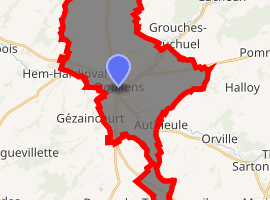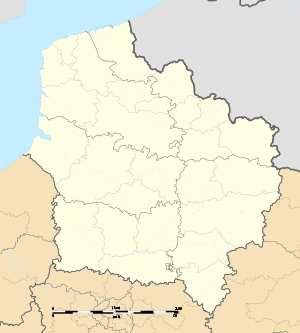Doullens
Doullens is a commune in the Somme department in Hauts-de-France in northern France.
Doullens | |
|---|---|
The town hall in Doullens | |
 Coat of arms | |
Location of Doullens 
| |
 Doullens  Doullens | |
| Coordinates: 50°09′27″N 2°20′29″E | |
| Country | France |
| Region | Hauts-de-France |
| Department | Somme |
| Arrondissement | Amiens |
| Canton | Doullens |
| Intercommunality | CC Territoire Nord Picardie |
| Government | |
| • Mayor (2001–2015) | Christian Vlaeminck |
| Area 1 | 33.4 km2 (12.9 sq mi) |
| Population (2017-01-01)[1] | 6,106 |
| • Density | 180/km2 (470/sq mi) |
| Time zone | UTC+01:00 (CET) |
| • Summer (DST) | UTC+02:00 (CEST) |
| INSEE/Postal code | 80253 /80600 |
| Elevation | 52–152 m (171–499 ft) (avg. 64 m or 210 ft) |
| 1 French Land Register data, which excludes lakes, ponds, glaciers > 1 km2 (0.386 sq mi or 247 acres) and river estuaries. | |
Its inhabitants are called Doullennais and Doullennaises.[2]
Geography
Doullens is situated on the N25 road, in the northern part of the department, straddling the river Authie, the border with the Pas-de-Calais. Doullens is practically mid-way on the intersection of these axes :
History
- Doullens, the ancient Dulincum, was seat of a viscountship under the counts of Vermandois then of Ponthieu (Hare) and an important stronghold in the Middle Ages.[3]
- In 1225, the town became part of France.
- In 1475 it was burnt by Louis XI for openly siding with the Duke of Burgundy.[3] It received its name Doullens-le-Hardi from its gallant defense in 1523 against the Anglo-Burgundian army.
- In 1595 it was besieged and occupied by the Spaniards, who massacred the entire population. It was restored to France by the Peace of Vervins (1598).[3]
- On 26 March 1918, orders giving General Foch overall command of the allied forces on the western front were signed in a room in the town hall. A link to those orders can be found in the May 22, 1928 edition of 'The Times' of London, found here.
Sites and monuments
Sites and monuments include:
- the ruins of Saint-Pierre, partly of the 13th century, used as a barn in the nineteenth century (Hare).
- Notre-Dame church.
- the early 17th century brick belfry.
- the citadel, possibly built by Vauban or Jean Errard, which has often served as a state prison, and later, a reformatory for girls.
Town motto
Infinita decus lilia mihi prestant
Population
| Year | 1936 | 1946 | 1954 | 1962 | 1968 | 1975 | 1982 | 1990 | 1999 | 2006 |
|---|---|---|---|---|---|---|---|---|---|---|
| Population | 5770 | 5404 | 6169 | 6321 | 7119 | 7495 | 7054 | 6615 | 6279 | 6820 |
| From the year 1962 on: No double counting—residents of multiple communes (e.g. students and military personnel) are counted only once. | ||||||||||
Notable residents
- The artist Édouard Traviès was born in Doullens in 1809.[4]
- Louis Auguste, Duke of Maine was imprisoned in the Doullens citadel from 1718 until 1720 for his part in the Cellamare conspiracy.[5]
- The nobleman Emmanuel Marie Michel Philippe Fréteau de Saint-Just was imprisoned in the citadel in 1788.[6]
Gallery
 Church of St-Pierre
Church of St-Pierre Notre-Dame church
Notre-Dame church Belfry and Tourist office
Belfry and Tourist office_2.jpg) Interior of the Citadelle
Interior of the Citadelle Notre-Dame church seen from the Citadelle
Notre-Dame church seen from the Citadelle- Doullens belfry, in the 19th century
 Information placard of the Citadelle
Information placard of the Citadelle_carnaval_085.jpg) Summer Carnival in Doullens (2009)
Summer Carnival in Doullens (2009)
See also
References
- "Populations légales 2017". INSEE. Retrieved 6 January 2020.
- "Annuaire-Mairie"
-

- Bellier de La Chavignerie, Émile and Auvray, Louis (1885). Dictionnaire général des artistes de l'École française depuis l'origine des arts du dessin jusqu'à nos jours, Vol. 2, p. 588. Librairie Renouard (in French)
- D'Harmonville, A. (ed.) (1845). Dictionnaire des dates, des faits, des lieux et des hommes historiques, Vol. 2, p. 255. Alphonse Levavasseur et Cie (in French)
- Assemblée nationale de France."Emmanuel, Marie, Michel, Philippe Fréteau de Saint-Just" Retrieved 15 May 2017 (in French)
- Augustus Hare, North-eastern France 1896:76.
External links
| Wikimedia Commons has media related to Doullens. |
- Doullens on the Doullennais site (in French)
- Site of Vals d'Authie, Nièvre, and Somme (in French)
- Official commune site (in French)
- Site of the tourist office (in French)
- Photos (in French)
This article is issued from Wikipedia. The text is licensed under Creative Commons - Attribution - Sharealike. Additional terms may apply for the media files.